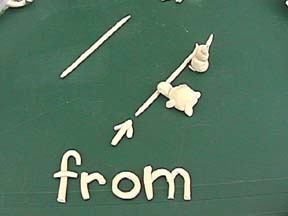Math Problems? or Trigger Words?

The majority of kids could tackle a question like this with ease. However, children with dyslexia may stumble over such a question. Why is that so?
Dyslexics tend to think primarily in pictures and images as opposed to words. When they encounter certain symbols (and all words are symbols), they get confused by those whose meaning they cannot picture. These are often high-frequency words that we use a lot of in the English language, such as ‘a’, ‘the’, ‘by’, ‘to’, etc. When they cannot begin to think with that word in picture form, they do not know how to make sense of a sentence.
So in the example question above, a dyslexic may be confused by the word ‘from’. The child may be able to recognise and pronounce the word ‘from’ when he sees it, but he does not know the meaning and so he does not know what he needs to do to begin to solve the question.
After much drilling and repetition to no avail to help the child understand the question, the child is then told by a well-meaning parent or tutor that whenever he sees such questions, he just needs to take the bigger number and subract the smaller number. By doing so, the child is taught rote learning, rather than gaining real understanding or true mastery of the subject.
If we could acknowledge the child’s picture thinking style, we can help the child master the meaning of ‘from’ and let him create a picture of what it means. According to the American Heritage Children’s Dictionary, ‘from’ means beginning at, starting with. Once the child understands the meaning, he can now picture what the question is asking him to do.
Subtract 79 from 139 means that he has to begin at, start with (ie from) 139, and then minus or take away 79, in order to derive at the answer. Visually, he would be able to put 139 down on paper, followed by the minus sign and 79 below 139 and then do his workings to get to the answer.
By extension, a dyslexic child very often can’t do problem sums not because he does not have the skill to do arithmetic, but because he does not understand what the question is asking of him in the first place, as he can’t think with some of the words that are in the question.
This article was originally published on the Singapore Dyslexia Blog.










